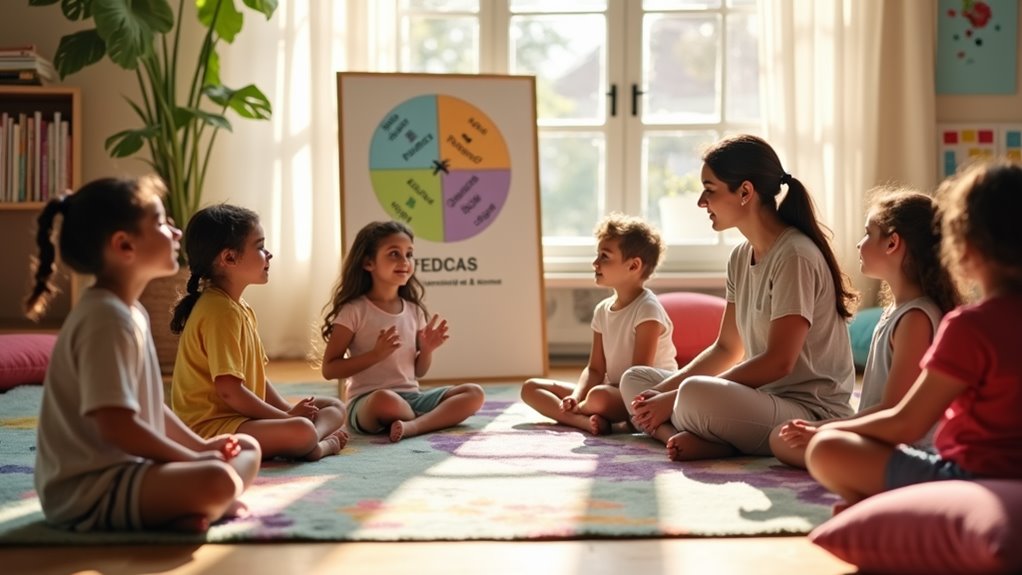To help children with emotional regulation, start by teaching them to recognize their feelings. You can encourage deep breathing—like pretending to blow up a balloon—because it calms the mind. Encourage expressing emotions through drawing or journaling, which can be fun and creative! Modeling your own emotional responses shows them it's okay to make mistakes and ask for help. Creating a supportive and safe environment where kids feel heard is essential. Remember, progress takes time, and celebrating small victories makes the journey enjoyable. Stick around and you'll discover even more helpful ideas for nurturing emotional growth!
Understanding Emotional Regulation
Emotional regulation is like a toolkit that helps children manage their feelings effectively. Imagine your toolbox filled with different tools to fix things—well, emotional regulation works the same way! It gives kids ways to understand and control their emotions, so they don't feel like their feelings are controlling them.
When a child learns emotional regulation, they discover techniques to calm themselves down when they're upset or to express their happiness appropriately. It's like learning to ride a bike; at first, it seems tricky, but with practice, it becomes easier. You might start with simple tools, like deep breathing or counting to ten. These can help settle those big emotions, whether they're anger, sadness, or excitement.
You'll notice that emotional regulation isn't just about stopping negative feelings; it's also about enjoying the positive ones! When kids learn to celebrate their joy without going overboard, it keeps things balanced—like not adding too much hot sauce to your favorite dish.
Importance of Emotional Awareness
Recognizing and understanding emotions plays a pivotal role in emotional regulation. When you know what you're feeling, it's easier to manage those feelings. Think of it like having a map; if you know where you are, you can find your way! Emotions can be tricky, and sometimes they surprise you. One minute you're happy, and the next, you're frustrated. By being aware of these emotions, you can take a step back, breathe, and decide how to react.
Being emotionally aware isn't just about feeling good or bad; it's about noticing those little nudges inside you. It helps you understand why you might be acting a certain way or why a situation feels overwhelming. For example, if you feel anxious about a test, recognizing that emotion can help you calm down and focus on studying instead of panicking.
Plus, when you're aware of your emotions, you can communicate better. You can explain to friends or family how you're feeling, which means they can help you out.
Model Healthy Emotional Responses
Remember, it's also okay to admit when you're not perfect.
You might mess up and lose your cool sometimes, and that's part of being human!
Just apologize and explain how you'll do better next time.
This teaches kids that everyone is learning, just like them!
Create a Safe Environment
A supportive and nurturing atmosphere is essential for helping children develop emotional regulation skills. When kids feel safe, they're more likely to express their feelings without fear of judgment. You can create this environment by being open and approachable. Let them know that it's okay to share their emotions, whether they're happy or sad.
Set clear rules that promote respect and kindness. This helps kids understand that everyone's feelings matter. You might say, "We're a team here, and we support each other," which encourages them to be there for one another.
Also, make sure to listen actively when they speak. Eye contact and nodding can show that you truly care about what they're saying. Sometimes, a simple "I understand" can go a long way in making them feel valued.
Teach Deep Breathing Techniques
Creating a safe environment allows children to explore and express their emotions more freely, paving the way for teaching them practical skills like deep breathing. Deep breathing is like giving your child a superpower! It helps them calm down when they're feeling overwhelmed or anxious.
Start by showing them how to breathe deeply. Have them sit comfortably and close their eyes if they want. Encourage them to take a big breath in through their nose, letting their tummy expand like a balloon.
Then, they should slowly blow the air out through their mouth, imagining the balloon deflating. You can even count together—inhale for four counts, hold for four counts, and exhale for four counts.
Make it fun! You can say they're blowing away their worries like dandelion seeds or filling up a magical balloon. Practicing this a few times a day can make deep breathing a habit.
Remind them that it's okay to use this technique whenever they feel upset. With a little practice, deep breathing can be a handy tool in their emotional toolbox, helping them feel more in control and relaxed.
Use Visual Aids and Tools
Using visual aids and tools can make learning emotional regulation more engaging for children. Think about it: kids love colors, pictures, and fun activities! You can use charts, illustrations, or even emotion cards to help them recognize feelings. For example, create a feelings chart with goofy faces showing different emotions like happy, sad, or angry. It's a great way for kids to point out how they feel without using too many words.
You can also introduce mood meters or thermometers. These tools let children visually track their emotions throughout the day. When they see their mood rising, they can use deep breathing techniques to cool it down—just like a temperature!
Don't forget about storybooks, either. You can read stories that highlight emotional challenges, and then discuss how the characters handle their feelings. It's like a mini-lesson wrapped in a fun adventure!
Finally, try incorporating art supplies. Drawing or coloring can help kids express emotions they might struggle to verbalize. Who wouldn't feel better after doodling their worries away?
Encourage Expressive Play
Encouraging expressive play can be a powerful way for children to explore and manage their emotions. When kids engage in imaginative play, they can act out different feelings and scenarios, helping them understand their own emotions better. You might see them pretending to be superheroes, animals, or even chefs! This creative outlet allows them to express what they mightn't be able to say with words.
Try setting up a space filled with costumes, props, or even art supplies. Let them create their own stories. You could ask open-ended questions like, "What happens next?" or "How does the character feel?" This not only sparks their creativity but also encourages them to reflect on their feelings.
And don't worry if they get a little silly! Laughter is a great way to relieve tension. You might even pick up on their emotions and learn how to respond better.
Implement Mindfulness Practices
Expressive play can lead naturally to mindfulness practices, which help children become more aware of their feelings and surroundings. When you guide your child to slow down and focus on the present, they start noticing their thoughts and emotions without judgment.
Simple activities like deep breathing or mindful coloring can work wonders. For instance, ask your child to take a deep breath, hold it for a moment, and then let it out slowly. It's like blowing up a balloon, but way less messy!
You can also incorporate nature walks, where you encourage your child to observe the colors, sounds, and smells around them. Ask questions like, "What do you hear?" or "What's that smell?" This makes them pay attention and get in touch with their feelings.
Another fun idea is to create a "mindfulness jar." Fill a jar with water, glitter, and a few drops of food coloring. When shaken, the glitter swirls around, representing chaotic thoughts. As it settles, it's a reminder to calm down and focus.
With these practices, your child will learn to navigate their emotions and develop a sense of peace, one mindful moment at a time!
Foster Open Communication
To foster open communication with your child, start by creating a safe space where they feel comfortable sharing their thoughts and feelings. You can do this by setting aside time each day to chat—maybe during dinner or before bedtime.
Ask open-ended questions like, "What was the best part of your day?" This helps them express themselves without feeling pressured.
It's also important to listen actively. When they speak, give them your full attention. Put down your phone, make eye contact, and nod along. This shows you care about what they're saying.
Don't rush in with solutions; sometimes, they just need to vent. You might even find their stories are as wild as a superhero movie!
Encourage them to share their feelings, too. Let them know it's okay to feel sad, angry, or confused. You could say, "It's totally normal to feel that way."
This helps your child understand that emotions are part of being human. Plus, it keeps the lines of communication open, making it easier for them to talk about anything, even those weird dreams about flying cats!
Set Realistic Expectations
Once your child feels comfortable sharing their feelings, it's important to set realistic expectations for how they should handle those emotions. You won't expect them to be a robot, right? Emotions can be tricky, and it's perfectly normal to feel overwhelmed sometimes. Start by explaining that it's okay to feel sad, angry, or frustrated. Make it clear that these feelings don't have to control them.
Next, help them understand that managing emotions is a skill that takes time to develop. Just like learning to ride a bike, they might wobble at first, but with practice, they'll get better. Encourage them to express their feelings in a healthy way, like talking it out, drawing, or even writing in a journal.
Also, remind them that it's okay to seek help when they're feeling stuck. You're there to support them, and they don't have to navigate their emotions alone.
Celebrate small victories, like when they recognize their feelings or try a new coping strategy. It's all about progress, not perfection! So, keep the atmosphere light and fun, and watch as they grow more confident in handling their emotions.





